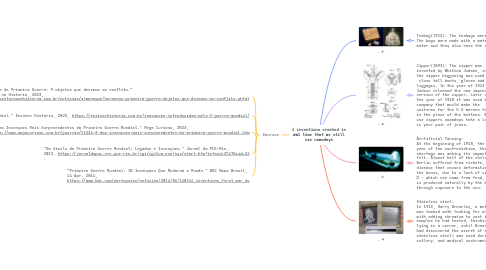4 inventions created in ww1 time that we still use nowadays
Carol Prestesにより

1. Sources
1.1. "A herança da Primeira Guerra: 9 objetos que devemos ao conflito." Aventuras na História, 2023, https://aventurasnahistoria.com.br/noticias/almanaque/herancas-primeira-guerra-objetos-que-devemos-ao-conflito.phtml .
1.2. "Inovações Introduzidas pela Primeira Guerra Mundial." Ensinar História, 2023, https://ensinarhistoria.com.br/inovacoes-introduzidas-pela-1-guerra-mundial/
1.3. "6 das Invenções Mais Surpreendentes da Primeira Guerra Mundial." Mega Curioso, 2023, https://www.megacurioso.com.br/guerras/51334-6-das-invencoes-mais-surpreendentes-da-primeira-guerra-mundial.htm .
1.4. "Um Século da Primeira Guerra Mundial: Legados e Invenções." Jornal da PUC-Rio, 2023, https://jornaldapuc.vrc.puc-rio.br/cgi/cgilua.exe/sys/start.htm?infoid=3547&sid=24 .
1.5. "Primeira Guerra Mundial: 10 Invenções Que Mudaram o Mundo." BBC News Brasil, 14 Apr. 2014, https://www.bbc.com/portuguese/noticias/2014/04/140414_inventions_first_war_mv
2. .
2.1. Teabag(1912): The teabags were invented by a German company called Teefix. The bags were made with a material so people can dip the bags inside the water and they also have the right amount of herbs inside them.
3. .
3.1. Zipper(1893): The zipper was invented by Whitcom Judson, in the zipper beggining was used to close tall boots, gloves and luggages. In the year of 1913 Judson released the new improved version of the zipper. Later on in the year of 1918 it was used by the company that would make the uniforms for the U.S marine forces in the place of the buttons. We still use zippers nowadays take a look in your pair of jeans.
4. .
4.1. Arrtificial Tanning: At the beginning of 1918, the last year of the confrontation, the shortage was making its impact felt. Almost half of the children in Berlin suffered from rickets, a disease that causes deformities in the bones, due to a lack of vitamin D – which can come from food, but is produced naturally by the body, through exposure to the sun.
5. .
5.1. Stainless steel: In 1913, Harry Brearley, a metallurgist at a company in Sheffield, England, was tasked with looking for another, more resistant alloy. He experimented with adding chromium to cast iron. It is said that he threw away the samples he had tested, thinking they had not worked. The material was left lying in a corner, until Brearley realized that the samples had not rusted. He had discovered the secret of stainless steel. “Rustless steel” (later called stainless steel) was used during World War I to make aircraft engines, cutlery, and medical instruments.


